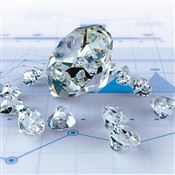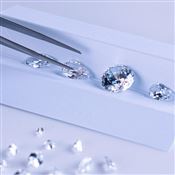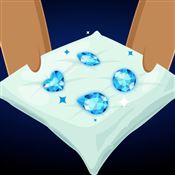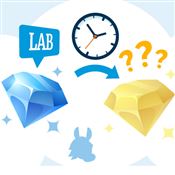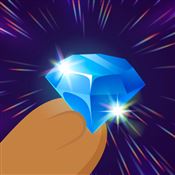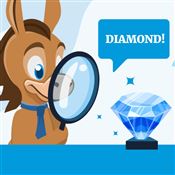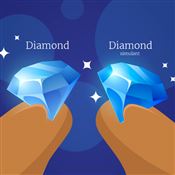Why Are Diamonds Expensive
What makes a diamond so special and valuable? Is it true that they are actually worthless?
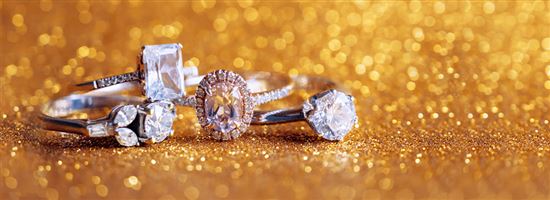 |
Diamonds are expensive because enough people are willing to pay a large amount of money for them.
Why? Marketing campaigns by De Beers depicted diamonds as a premium, rare product. Demand skyrocketed, and so did the prices.
In this article, you'll discover 11 surprising reasons that make diamonds so expensive, including which qualities drive up the price and the history of the infamous advertising campaigns:
11 Reasons Why Diamonds are Expensive
Popular demand, production costs, and quality combine to raise a diamond's price tag.
Popular Demand
Popular demand for diamonds is responsible for a huge part of the stone's price tag. Many people all over the world want to buy them. So diamond prices simply follow demand.
This demand is thanks to a bunch of strategies from diamond companies:
1. False Scarcity
Before the 20th century, diamonds were pretty rare. They were only found in small amounts in India and Brazil, explains diamond historian Edward Jay Epstein.
Around 1870, that all changed. Huge diamond mines were found in South Africa, and the businessmen who operated the mines panicked. This new supply of diamonds would kill demand.
To maintain the illusion of scarcity, the businessmen merged into one entity called De Beers Consolidated Mines Inc.
They took full control of the diamond mines, the supply, and the prices.
Within 10 years, De Beers had taken over 90% of the world diamond industry, creating a huge monopoly.
The false scarcity they created led people to believe that diamonds were rare. Thus, diamond prices skyrocketed.
2. Demand Creation
Once De Beers gained control over supply, they had to find a way to drive up demand.
Their plan was to get people to see diamonds as a symbol of romance, power, and love - plus, a valuable investment.
By doing this, people would consider diamonds to be a necessary part of relationships, marriage and "moving up" in the world. These were goals that most Americans had.
In the years following, De Beers created multiple marketing campaigns with that in mind.
3. Clever Marketing
De Beers paired up with New York Ad agency N.W. Ayer to create the infamous diamond marketing campaigns we still know today.
Magazine ads with Picasso and Dali made diamonds seem like works of art.
Diamond mine tours for the British Royal Family solidified diamonds as a status symbol.
Movies with Marilyn Monroe painted diamonds as glamourous and romantic.
Each of these campaigns would secure diamonds as the symbol of love, power, and wealth. Eventually, De Beers came up with it's official motto: "A Diamond is Forever."
Men and women wanted a piece of the romance and glamour that diamonds offered, and diamond sales went way up.
From the 20th century on, De Beers controls most of the diamond industry to keep demand up and supply "down". To this day, diamonds can be fairly pricey.
Diamonds are less expensive than gold because the value of gold is predictable and stable. Since gold is the most popular precious metal that can't be synthesized in a lab, unlike diamonds, it has stood the test of time and established itself as a safe and worthwhile investment.
Expensive Production and Supply Chain
A diamond incurs lots of costs as it travels from the mine to your finger. Here's an overview of the production and storage expenses needed to bring your diamond to you.
4. High Mining Cost
Did you know that miners need to move 200-250 tons of ore to uncover a single carat of diamond?
These high cost in labor and machines is another factor that drives diamond prices up. The actual amount varies a lot per mining company. But reports show that it takes as much as $340 per carat to mine a diamond.
5. Low Rough Yield
Once the mined rough is sent to be cut and polished, more than half of the rough gets thrown away. Manufacturers must make up for this loss by passing the cost to the buyer.
Why the big waste in diamond rough? To get the sparkliest stone, gem cutters must follow ideal measurements. And this will always mean sacrificing a big part of the rough.
For example, they can't just cut the rough too deep to make a bigger stone. If a diamond's too deep, it won't sparkle beautifully.
6. Difficult Cutting & Sorting
As the previous part shows, you need lots of skills, tools, and time to cut a diamond. It's the hardest material on earth. But if one tiny angle is off, you might end up with a subpar diamond.
Did we mention that diamond roughs must be sorted before they're cut? They're placed in over 12,000 categories based on their cut, clarity, color, and carat size.
That's a painstaking and costly process. But this stage is crucial since it decides what the finished stone will look like.
7. Financing Inventory
But the costs don't stop once the diamond has been polished. For the jeweler to show their diamonds to you, they must maintain their inventory. That means additional costs for warehouses, display cases, and shipping stones.
Diamond prices typically increase 4% per year, but this doesn't mean the diamond will have good resale value.
The resale market for diamonds is weak. As soon as you buy a diamond, the value has already gone down, so you shouldn't count on diamonds as an investment.
Quality of 4C's
Generally, higher quality diamonds command higher prices. Here's why:
8. Carat
Among the 4Cs, carat has the biggest influence on the price of a diamond. Even though a 0.99 carat and 1.00 carat diamond look the same, the 1 carat diamond can cost much, much more.
The price also increases exponentially, which means a 2.00 ct diamond will be much more than double the price of a 1.00 ct diamond.
9. Cut
Another important factor that determines the cost of a diamond is cut.
Cutting a diamond skillfully is difficult. Only expert diamond cutters can showcase the ideal proportion and symmetry of its facets. Plus, cut has everything to do with how brilliant a diamond appears.
10. Color
Diamonds exist in many hues and it's very rare to find a naturally colorless diamond (which is why they're extremely expensive and valuable).
Even just a small color difference, which can only be distinguished by a seasoned gemologist, can lead to a 10% difference in cost.
11. Clarity
The final "C" is clarity. This is a measurement of the flaws a diamond has.
"Blemishes" are exterior flaws like scratches and chips. "Inclusions" are interior flaws. The fewer flaws a diamond has, the higher the clarity grade, and thus, the more expensive it is.
LAB CREATED DIAMOND AS AN ALTERNATIVE
Think a diamond's price tag is too big for your budget? Then you might find your forever with a lab-grown diamond.
Lab created diamonds are up to 75% cheaper than their earth-mined counterparts. They're real diamonds. They're just as good and sparkly as natural diamonds, but for a fraction of the price.
Lab created diamonds get their cheaper price thanks to cheaper production costs. Their supply chain is also shorter, so there are less middlemen who charge their own mark-ups.
But before you say yes to a lab-grown diamond, discuss this with your partner first. We know that engagement rings are special, so you can't risk buying a stone that you don't like.
Bottom Line
Now that you know why diamonds are expensive and how the price is determined, you're better equipped to find the best diamond in your price range.
Apart from this, it's also crucial to talk with your loved one and understand their expectations and preferences. Remember, your partner may be wearing the ring, but this is ultimately a decision you make together. Best of luck!
Holly Zorbas is a assistant editor at CreditDonkey, a diamond jeweler comparison and reviews website. Write to Holly Zorbas at holly.zorbas@creditdonkey.com. Follow us on Twitter and Facebook for our latest posts.
|
|
|
